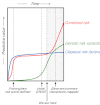Understanding cardiovascular disease: a journey through the genome (and what we found there)
- PMID: 22730474
- PMCID: PMC3380707
- DOI: 10.1242/dmm.009787
Understanding cardiovascular disease: a journey through the genome (and what we found there)
Abstract
Cardiovascular disease (CVD) is a major cause of mortality and hospitalization worldwide. Several risk factors have been identified that are strongly associated with the development of CVD. However, these explain only a fraction of cases, and the focus of research into the causes underlying the unexplained risk has shifted first to genetics and more recently to genomics. A genetic contribution to CVD has long been recognized; however, with the exception of certain conditions that show Mendelian inheritance, it has proved more challenging than anticipated to identify the precise genomic components responsible for the development of CVD. Genome-wide association studies (GWAS) have provided information about specific genetic variations associated with disease, but these are only now beginning to reveal the underlying molecular mechanisms. To fully understand the biological implications of these associations, we need to relate them to the exquisite, multilayered regulation of protein expression, which includes chromatin remodeling, regulatory elements, microRNAs and alternative splicing. Understanding how the information contained in the DNA relates to the operation of these regulatory layers will allow us not only to better predict the development of CVD but also to develop more effective therapies.
Figures


References
-
- Bamshad M. J., Ng S. B., Bigham A. W., Tabor H. K., Emond M. J., Nickerson D. A., Shendure J. (2011). Exome sequencing as a tool for Mendelian disease gene discovery. Nat. Rev. Genet. 12, 745–755 - PubMed
-
- Bartel D. P., Chen C. Z. (2004). Micromanagers of gene expression: the potentially widespread influence of metazoan microRNAs. Nat. Rev. Genet. 5, 396–400 - PubMed
-
- Bastiaenen R., Behr E. R. (2011). Sudden death and ion channel disease: pathophysiology and implications for management. Heart 97, 1365–1372 - PubMed
Publication types
MeSH terms
LinkOut - more resources
Full Text Sources
Medical

